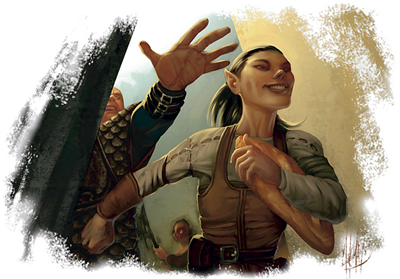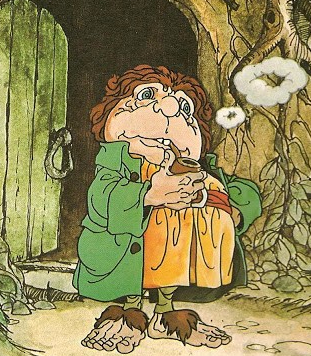

Mention thieves to a band of adventurers,
and every eye will suddenly turn to
stare at the halfling in the next-to-last rank
who has been trying very hard to look inconspicuous.
Mention thieves to a group of players
rolling up a new party of characters, and
someone is bound to ask, ?Do we really
need one of those? The last thief we had
stabbed Roger Ramjet in the back and got
away with his + 4 sword.? Shortly afterward,
somebody manages to come up with
statistics good enough to start a monk.
Mention thieves to a DM, and his or her
eyes will roll while a resigned sigh blows
over the referee?s screen. ?Thieves are a
pain in the neck,? you?ll be told. ?In order
to be sneaky and devious, they have to pass
me notes ? which lets everybody else know
they?re trying to be sneaky and devious.
And then I have to cope with dozens of little
scraps of paper I can only decipher half the
time anyway!?
All those reactions are based on the same
kind of thief ? the nasty little halfling who
filches gems at every opportunity and disappears
at the slightest drop of a twenty-sided
die. Unfortunately, that?s the sort of thief
with which most gamers are best acquainted.
Even the occasional human or elfborn
thief is usually of the same
unpredictable stock, and remains difficult
for fellow adventurers to tolerate on a longterm
basis.
That's a bit surprising, considering the
fact that the thief is the only character class
in the AD&D® game open to
members of
any demi-human race, and that almost no
restrictions exist on the number of experience
levels thieves may attain. Still, thieving
behavior patterns remain stubbornly
entrenched; even in Roger Moore?s excellent
series of articles on the races in
DRAGON® issues #58 to #62 (reprinted in
The Best of DRAGON anthology, Vol. 3),
descriptions of demi-human thieves suggest
that they follow their professional instincts
first and their racial instincts second.
Such a characterization not only doesn?t
make psychological sense, it unnecessarily
limits the potential diversity and range
available to aspiring players of thieves. In
fact, there?s no particular reason that all
thieves have to be marginally trustworthy at
best, or perpetually greedy and selfish at
worst. A thief?s race will almost always have
a profound effect on the way he or she
functions in a game setting, and that effect
won?t necessarily make the character a
liability to an adventuring party. A look at
each race illustrates the differences in outlook
that demi-human thieves possess.
Elven eavesdroppers
As Roger Moore observed in DRAGON
issue #60, elves place a lower value
than
most other races do on personal property,
largely because of their exceptionally long
lifespans. As a result, elven thieves are
likely to use their special skills to acquire
another commodity of more importance:
knowledge. Elves, with their inherent knack
for ferreting out secret doors and their
generally superior senses, are already keen
observers. Add to this a thief?s ability to
hide and move silently, and the result is a
character uniquely suited to gathering all
kinds of information and discovering all but
the most carefully guarded secrets. (An
elven thief residing in a populated area is at
least 75% likely to be aware of any political
or adventuring activity ? including military
movements ? before the normal inhabitants
find out what is going on. This
statistic, of course, applies exclusively to
NPCs and would vary with individual
circumstances.)
That?s not to suggest, however, that elven
thieves are exclusively devoted to uncovering
other kinds of knowledge, notably concerning
the whereabouts of long-lost magics
and mysterious civilizations. These thieves
do spend part of their time researching
likely prospects, either in musty old libraries
or in and around the homes and guildhalls
of various wizards and sages. They are also
adventurers, though, following up the clues
and persistently journeying into remote
areas in quest of abandoned towers and
cities.
On such expeditions, these elves often
employ magic items and carry away plunder
that would ordinarily be neglected by
members of other races. In particular, they
are fond of the various informationdetecting
wands (some have been known to
wear similar devices in the form of rings),
and they are far more likely to collect old
books, scrolls, and tapestries ? magical or
otherwise ? from their dungeon visits than
they are to come home with bags of gold
and silver. Though such treasure may seem
bulky and of relatively low value, elven
thieves can sell any book or artwork of
historical interest for 10% to 20% more
than can their colleagues of other races.
Although elf-born thieves value knowledge
highly ? and are not above making
that fact abundantly clear to characters
seeking it ? they are not as a rule especially
secretive. They will always share information
about their goals and intentions with
adventuring colleagues (though they may
not reveal the full value or power of a
sought-after magical item if they fear a
party member might try to seize or misuse
it), and they are less reticent than most
other thieves about tales of their past exploits
and adventures. Further, while elves
are only rarely members of a thieves? guild,
they will generally display the same high
degree of professional reliability that marks
a guild-affiliated thief on an assignment.
Q. Can elven thieves
use bows?
A. No. Despite
the fact elves are
traditionally master
bowmen, an
elven thief is limited
by the restrictions
of class, in addition
to those of
race.
<Update, UA: Thieves
can use short bows>
(Imagine #9)
The wandering half-elf
The Half-Elf Point
of View +
The number of half-elves who adopt the
profession of thief is relatively small. While
such characters share the enhanced senses
and interest in information of their demihuman
ancestors, they are unmistakably
human in their taste for intrigue and deception.
As a result, half-elven thieves tend to
avoid elvish communities and kingdoms,
instead traveling extensively and mixing
with human society as much as possible.
The half-elf?s abilities set the tone for the
brand of thievery he practices. Half-elven
thieves are masters of the confidence game
and the elaborate swindle, preferring to
make a profit from showmanship and misdirection
rather than by brute force or armed
confrontation. For instance, a half-elf arriving
in a middle-sized town might eavesdrop
on a wealthy magician, then turn up on his
doorstep the next day with a map leading to
the hiding place of a valuable item the mage
just happens to be hunting for. Would the
wizard be interested in buying the information?
What about financing an expedition to
search for the item? Of course, by the time
the spot has been reached, the item is no
longer there ? but the thief has long since
collected his fee and vanished.
While their tendency to shade the truth
makes them potentially awkward traveling
companions, half-elves are generally cautious
enough to make the problem a minor
one, at least in fairly large parties where the
thief is clearly in the minority. (After all,
half-elven thieves do spend a lot of time on
the road, and it doesn?t pay to bite the hand
that?s protecting you.) A half-elf's first
priority in such circumstances is his own
personal safety; in a conflict between potential
profit and potential injury, discretion
will almost always prevail. In fact, a halfelven
thief may go to some length to make
himself useful to a group of adventurers if
he expects to need their protection in the
immediate future ? though his loyalty will
rarely extend to sharing the profits of a
private project. The thief usually won?t stay
with the same adventuring party for longer
than it takes to safely reach the third or
fourth town along the road, where he can
begin a new swindle with little fear that his
reputation has preceded him. (He might,
however, rejoin the party the next time it
passes through if escape is necessary by
then.)
Dwarven locksmiths
The Dwarven Point
of View +
The majority of dwarves belonging to the
?thief? character class are not thieves at all,
in the criminal sense of the word. Rather,
they are experts at designing and crafting
the very locks, traps, chests, and vaults that
other thieves are so eager to bypass or rob.
Just as many dwarves are superb and wellregarded
armorers and weapons makers,
the bulk of dwarven ?thieves? are really
locksmiths, cabinetmakers, or architects
who specialize in keeping things safe from
robbery.
Although many of the dwarves who possess
thieving skills don?t use them to steal
(and frequently don?t even adventure,
instead residing in towns or dwarven communities
where their skills are eagerly
sought by merchants and nobles), they often
practice their crafts for other related purposes.
The 2 most frequently encountered
examples of this are the troubleshooter and
the liberator.
A troubleshooter is a special breed of
locksmith/designer who specializes in testing
elaborate locks and traps for clients worried
abou the safety of their valuables or the
impregnability of their dungeons. Such a
character may be assigned to steal a
piece of jewelry from a locked VAULT or to
break out of a supposedly escape-proof
prison. If he fails, the troubleshooter has
proven the worth of the protective device; if
he succeeds, he offers advice to his clients
on how to prevent future thieves from repeating
the feat. Such service is always
costly, but is utterly reliable and generally
worth the investment if a client wants to feel
truly secure.
Liberators are rarer, but more closely
allied to the usual concept of the thieving
class. These are thieves especially trained
and outfitted to recover valuables that have
already been stolen ? usually from other
dwarves, but sometimes from clients who
pay for the service just as they would for a
troubleshooter. These dwarves (who are
sometimes trained as fighters as well) pick
locks and disarm traps ? frequently remarking
on their inferior construction as
they do so ? in single-minded pursuit of
whatever they have been assigned to bring
back. They are fiercely proud of their abilities
and their dwarvish heritage, and woe
betide anyone who suggests that a liberator
is less than honorable!
Not many dwarven thieves adopt the
adventuring lifestyle, but those who do are
more often liberators than trouble-
shooters, and most of these have been cast
out of dwarven society for some act of theft
against another dwarf or a client or ally. It
is not entirely safe to generalize about these
outcasts; although most continue to be
staunch upholders of dwarven superiority
and of the fierce professional honor that is a
dwarfs trademark, they can also be unpredictable
and occasionally dangerous. Some
outcasts ? perhaps the majority ? have
learned from the mistakes for which they
were banished, and have adapted fairly well
to the benign questing of the adventurer. A
few, however, feel so deeply wronged by
their fellow dwarves that they turn to the
darkest side of the thieving profession.
These unstable characters pillage and destroy
wherever they go, taking special
vengeance on any other dwarves who may
cross their paths and treading periously
close to the ways of the assassin. But these
?dark dwarves? are quite rare, and dwarven
thieves generally make solid, reliable
adventuring partners who are especially
handy in underground settings.
The FUN-loving gnome
The Gnomish Point of View
+
Gnomes, more than any other racial
type, take pure pleasure from the act of
stealing. This outlook, however, stems not
from a tendency toward evil but from sheer
gnomish delight in slipping through intricately
crafted defenses and collecting a
valuable prize. While other races consider
thievery a profession, gnomes practice it as
a recreational pursuit ? with much the
same devotion that DRAGON Magazine's
readers are likely to pursue role-playing
games.
As a result, gnomes are much more deserving
of the title ?burglar? than the halflings
to whom the description is more often
applied. If a wealthy merchant reports that
a valuable jewelry collection has vanished
from the double-locked false bottom of a
chest hidden in his most secret closet, the
odds are good that the thief responsible was
a gnome. If an adventuring party hasn?t
been able to collect a particular treasure
from a nearby dungeon because it?s too well
defended by an intricate series of traps,
their surest solution is to take the problem
to the nearest gnome settlement ? though
it may cost them a fair percentage of the
hoard, any thieves there will be likely to
jump at the opportunity.
Yet while gnomes have developed an
almost legendary reputation for succeeding
at ?impossible? burglaries, they are by no
means infallible. Indeed, their failures are
often as spectacular as their achievements
?and the gnomes do not always mind, so
long as they can get a good story out of the
episode. The reason for this is that gnomes
carry out their thieving activities less by
careful planning and organization than by
instinct and impulse. In this way, a gnome?s
thieving habits are not unlike those of a
pack rat: if he sees something that looks like
an interesting trinket, he is liable to drop
whatever he?s doing at the time to make a
stab at collecting it.
This ?pack rat? mentality also influences
the kinds of objects a gnome will steal and
what he does with them afterward. Gnomes
are, of course, especially attracted to gems
and jewelry (the more valuable, the better);
they are also easily seduced by the lure of
magic items, especially those with some
form of illusion-producing power. They are
not, by contrast, especially interested in
hoards of mere coin or other bulky goods,
since a gnome does not usually sell the
items he steals. Rather, he keeps them to
admire their beauty (in the case of gems
and such) or their magical powers. But as
time passes, gnomes often lose interest in
their less valuable prizes, and have been
known to leave them behind in place of
newly stolen items of greater value ? hence
the comparison to the pack rat. This is
especially true of adventuring gnomes, who
are frequently traveling and cannot easily
amass more loot than they can carry.
Characters whose parties include thieves
of gnomish extraction are usually in little
danger of being betrayed or backstabbed. In
fact, while gnomes are normally reluctant to
start a fight, they are quick to leap to a
friend?s defense. But adventurers who travel
with gnome thieves should be prepared to
make allowances for the gnomes? unique
personalities, particularly in two respects.
First, they should not be surprised to occasionally
find themselves the butt of the
gnome?s practical jokes, which are always
intended purely to amuse (and perhaps to
embarrass) but not to injure. Secondly,
fellow adventurers should be most careful to
avoid short-changing gnome thieves when
the time comes to divide treasure. A gnome
who feels his contributions have been undervalued
or who especially craved a particular
bracelet will not be above collecting
?his rightful due? from a fellow party member,
though the gnome is likely to leave
sufficient gold in his victim?s purse to more
or less balance the shares.
The half-orc's priority
The Half-Orc Point of
View +
Half-orcs of any class don?t seem to be
found in great numbers in the average
gaming campaign; half-orc thieves, if anything,
are found even less frequently. It may
be just as well, for half-orcs make perhaps
the single deadliest sort of thieves a party is
likely to encounter.
Meetings with half-orc thieves, as a rule,
will not occur in dungeons or other remote
settings where an adventuring group is
hunting for hidden treasure. Instead, they
are likely to take place in the dark alleys of
large cities and towns, or on fairly welltraveled
but under-patrolled roads between
such communities. This is because half-orcs
are almost invariably practitioners of the
?art? of armed robbery ? the easiest, least
subtle form of stealing. Half-orcs typically
lack the patience and subtlety to make good
burglars, are often failures as pickpockets,
and are too self-centered to work well in
groups. That leaves strong-arm tactics as
the most reliable means of making a quick
gold piece on which to survive.
The more intelligent half-orc thief will
almost always take up the role of highwayman,
either alone or as the leader of a small
band of significantly weaker bandits. He
knows that as a half-orc, he won?t easily fit
into city life, where he will be viewed with
constant suspicion and where patrols of
guards are entirely too frequent. He will lie
in wait for merchants and adventurers,
robbing them by force if practical or by the
dark of night if necessary.
Such highwaymen, however, do not make
up the majority of half-orc thieves, though
they are often the most powerful and
longest-lived of their race. The majority of
half-orcs who adopt the thieving profession
are quickly hired as enforcers and strongarm
thugs by crime lords and powerful
guildmasters in urban areas, serving much
the same purpose as the hired gunmen and
goons employed by modern-day organized
crime bosses. That purpose, of course, is to
threaten reluctant clients and customers
with violence unless they do as they?re told
?and to carry out the threats if necessary.
In one respect, half-orcs would seem
unsuited to the status of hireling; their
typical ?me first? attitudes suggest that
they would make unsafe employees at best.
But the masters of half-orc thugs take great
care to retain the loyalty of their staffs.
These measures include regular (and reasonably
good) pay, fairly close supervision,
and active efforts to keep hired enforcers
from using the full range of their thieving
skills. Most significantly, such hirelings are
strongly discouraged from searching for and
removing traps, a practice which decreases
the likelihood that a thug will be able to
make off with his employer?s carefully secured
loot or acquire professional secrets
which could be sold to a rival. If kept on a
short leash, a half-orc thief is almost as
reliable a killer as a genuine assassin.
Very few half-orc thieves remain to join
adventuring parties, and even fewer remain
with such groups for long. A good percentage
are quickly done in by unlooked-for
traps (and, to a half-orc in a dungeon, most
traps are unlooked-for). Most of the others,
once they have identified the most valuable
treasure carried by party members, will
steal the best items and leave their victims
in no condition to pursue. In short, no
matter what the circumstances may be, an
encounter with a half-orc thief is likely to
leave the thief's opponent worse off than he
was before.
Halflings: another look
The Hobbit Point
of View +
Popular reports have characterized halfling
thieves as sly, avaricious tricksters who
should be trusted only as far as high-level
fighters can throw them. Closer observation
of halfling society, however, reveals that this
portrait is almost entirely without foundation.
In fact, such characters may be among
the most reliable adventuring companions
imaginable.

The sheer greed that so many treasure
seekers associate with halflings is the first
casualty of a serious investigation. Though
halflings do value their comfort, especially
in their own homes and villages, they are
not particularly interested in money, gaudy
jewelry, or even magic. Rather, the possessions
they value are useful as well as attractive
and durable: furniture, good food,
fine
ales and tobaccos, and the like.

While the preceding description applies
chiefly to halflings who stay at home and
lead quiet, peaceful lives, those who take up
the adventuring lifestyle are not very different.
Almost all halfling adventurers belong
to the thief character class; fighters and
clerics tend to stay at home serving and
protecting their villages. The single personality
quirk that distinguishes these travelers
and explorers from other halflings is an
intense, constant curiosity about the world
beyond the hills visible from the parlor
window. Halfling thieves aren?t satisfied
with mere stories about dragons, twothousand-
foot waterfalls, or cities built of
rainbow-colored glass; they want to see all
these things for themselves.

A halfling?s inquisitiveness, however, can
never entirely overwhelm the shy caution
that is the race?s trademark, nor can it keep
them from complaining periodically about
the danger, discomfort, and uncertainty that
go with an adventuring life. As a result,
halflings often go to some length to avoid
encounters with unknown persons and
creatures, making themselves as inconspicuous
as possible until they are sure it is safe
to emerge from their hiding places. And
they are wary of any situation where they
are offered something for nothing; halflings
are shrewd bargainers who know there is
usually a catch to such transactions.
It may be noted that this description of
halfling thieves makes virtually no reference
to stealing or to other skills normally associated
with the thief class. This is not unintentional;
rather, it mirrors the almost
complete lack of attention paid by halflings
to such matters. To a halfling, treasure and
other material rewards for adventuring are
basically irrelevant, and in fact, halflings
have been known to refuse enormous rewards
and turn down chances to collect
magnificent treasures -- such things are
frequently too cumbersome to be easily
transported, and often are not likely to be
very useful once they are dragged home.
This is not to say that halflings lack the
skills possessed by other thieves ? though
it?s a mystery where they acquire them,
since very few of the little folk engage in
locksmithing or metalwork, and no halfling
society yet discovered is host to a thieves?
guild. The difference is in the use to which
halflings employ these talents to protect and
rescue themselves and their associates when
an adventure somehow gets out of control.
As long as the party is proceeding smoothly
toward its goal or destination, a halfling
thief is likely to spend most of his time
admiring the scenery. Only when trouble
starts will he rush to set things right, dart-,
ing bravely (but never foolishly) into combat,
or scurrying to free trapped comrades.
All this is done matter-of-factly and without
undue fuss; any praise heaped on a
halfling?s shoulders afterward will probably
be shrugged off lightly, often with grumbles
that the crisis wasn?t his fault. Such gratitude
is still well deserved. A halfling will
never willingly desert a companion in need,
and may go to truly amazing lengths to
effect a rescue.
Thieves and thieves
It should be clear from the preceding
sketches that the character class labeled
"thief" is by no means as narrowly
specialized
as the name would suggest. Though
many members of the character class are
thieves in the more conventional sense of
the word, just as many are reasonably lawabiding
folk who would be insulted if their
friends and companions accused them of
being criminals. In particular, demi-human
thieves illustrate this point as a result of the
vastly different worldviews held by each of
the races. To put it simply: There are
thieves, and there are thieves ? and then
some. Calling someone a thief in the real
world implies some fairly specific legal and
moral judgments, but saying the same thing
about a character in a game campaign
doesn?t carry the same impact. Further
details are necessary before players can
make judgments about thief characters.
Among those details, the thief's race is one
of the most significant.